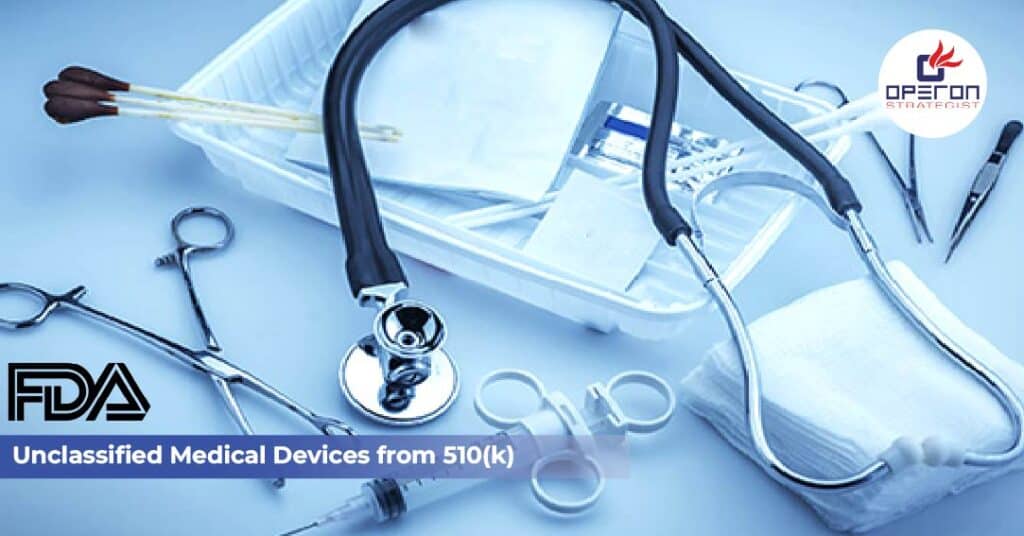Introduction
When manufacturers think of the FDA 510(k) pathway, the focus is usually on Class I and Class II medical devices that require premarket clearance. But what happens when a device does not clearly fall into any existing FDA classification? This is where Unclassified Medical Devices from 510(k) come into play. Understanding this special category is important for medical device startups and manufacturers who want to bring new technology into the US market without delays.
In this blog, we’ll cover what unclassified medical devices are, how they are handled in the 510(k) process, and what manufacturers should know before filing.
Must Read: FDA Medical Device Classification
Looking For a Medical Device Regulatory Consultant?
Let’s have a word about your next project
What Are Unclassified Medical Devices?
Medical devices in the United States are generally grouped into three categories:
- Class I – Low risk, often exempt from 510(k)
- Class II – Moderate risk, usually require 510(k) clearance
- Class III – High risk, typically require Premarket Approval (PMA)
However, some devices do not fit neatly into these categories. These are called unclassified medical devices.
Unclassified devices are:
- Products that were legally marketed before May 28, 1976, when the Medical Device Amendments were passed.
- Devices for which the FDA has not yet assigned a final classification.
- Devices that may still require a 510(k) submission for clearance before they can be marketed.
In short, Unclassified Medical Devices from 510(k) are devices that fall outside the existing regulatory categories but are still cleared through the 510(k) process.
Why Do Unclassified Medical Devices Exist?
Unclassified devices exist because FDA classification is an evolving process. Over the years, new technologies, novel materials, and unique device functions have emerged. Not every product immediately receives a class designation.
There are three main reasons why a device might be unclassified:
- Pre-Amendment Status – Devices that were marketed before 1976 but never assigned a formal class.
- FDA Review in Progress – Devices currently under review where FDA has not issued a final classification.
- Unique Device Features – Devices that don’t match existing product codes or classifications due to innovative design or function.
Examples of Unclassified Medical Devices
Some examples of Unclassified Medical Devices from 510(k) include:
- Devices that have been in use for decades but were never formally classified.
- Novel technologies that do not align with existing product categories.
- Devices reviewed under specific circumstances where FDA has not yet assigned a permanent classification code.
For instance, certain diagnostic and therapeutic devices initially entered the market without classification and later received a defined class after FDA evaluation. Until that point, they remain unclassified but require 510(k) clearance.
The 510(k) Pathway for Unclassified Devices
Even though these devices are “unclassified,” they still need to go through the 510(k) clearance process. Manufacturers must prove that the device is substantially equivalent to a legally marketed device (predicate).
The steps include:
- Identify Predicate Device – Find a legally marketed device that is similar in safety and performance.
- Prepare a 510(k) Submission – Include device description, intended use, performance testing, biocompatibility data, and labeling.
- FDA Review – FDA examines whether the device is substantially equivalent to the predicate.
- Clearance – If approved, the device is cleared under 510(k), even if it remains unclassified.
Challenges for Manufacturers
Working with Unclassified Medical Devices from 510(k) can be challenging because:
- Lack of Clear Guidance – Without a defined classification, manufacturers may struggle to find the right predicate.
- Extended Review Time – FDA may take longer to review submissions since there’s no established regulatory history.
- Risk of Reclassification – FDA can later reclassify the device into Class I, II, or III, which may change compliance requirements.
Because of these challenges, manufacturers often seek help from experienced medical device consultants who understand how to navigate the process.
How FDA Eventually Handles Unclassified Devices
Over time, FDA works to assign classifications to unclassified devices. The process usually involves:
- Advisory Panel Review – Expert committees review the device type.
- Proposed Rulemaking – FDA publishes a proposed classification in the Federal Register.
- Final Rule – Device receives an official class (I, II, or III).
Once classified, manufacturers must comply with the updated regulatory requirements.
Why Understanding Unclassified Devices Matters
For startups and established manufacturers, recognizing the role of Unclassified Medical Devices from 510(k) is critical. Misinterpreting the category can delay product launch, increase compliance risks, and affect market entry timelines.
By planning, you can:
- Identify the correct regulatory pathway early in product development.
- Prepare stronger 510(k) submissions with supporting evidence.
- Avoid unnecessary delays caused by uncertainty in classification.
Not sure how to handle Unclassified Medical Devices from 510(k)?
Operon Strategist Can Help
If your device falls into the unclassified category, you don’t need to navigate the 510(k) process alone. At Operon Strategist, we specialize in helping manufacturers:
- Determine the right pathway for 510(k) submissions
- Find suitable predicate devices
- Prepare complete submission documentation
- Communicate effectively with the FDA to reduce review times
Our team works with startups, manufacturers, and importers across the USA to simplify regulatory approval and ensure faster time to market.
Need guidance with Unclassified Medical Devices from 510(k) or other FDA submissions?
Contact Operon Strategist today to discuss your project and take the first step toward FDA clearance.
FAQs
1. What are Unclassified Medical Devices from 510(k)?
Unclassified medical devices are products that do not fit into FDA’s Class I, II, or III system but still require a 510(k) clearance before marketing.
2. Do unclassified medical devices still need 510(k) clearance?
Yes, even though they lack a defined class, most unclassified devices must undergo the 510(k) process to show substantial equivalence to a predicate device.
3. How does FDA eventually classify unclassified devices?
The FDA may assign them to Class I, II, or III after advisory panel reviews, rulemaking, and final classification decisions.
- adminhttps://operonstrategist.com/author/admin-2/
- adminhttps://operonstrategist.com/author/admin-2/
- adminhttps://operonstrategist.com/author/admin-2/
- adminhttps://operonstrategist.com/author/admin-2/




